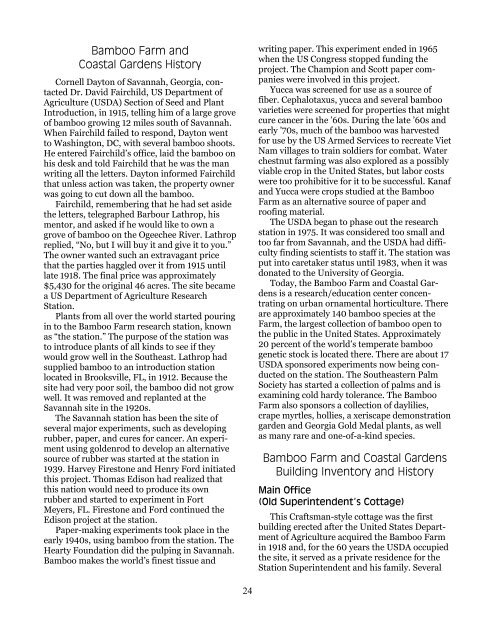Growing Bamboo in Georgia - Orange County Extension Education ...
Growing Bamboo in Georgia - Orange County Extension Education ...
Growing Bamboo in Georgia - Orange County Extension Education ...
Create successful ePaper yourself
Turn your PDF publications into a flip-book with our unique Google optimized e-Paper software.
<strong>Bamboo</strong> Farm and<br />
Coastal Gardens History<br />
Cornell Dayton of Savannah, <strong>Georgia</strong>, contacted<br />
Dr. David Fairchild, US Department of<br />
Agriculture (USDA) Section of Seed and Plant<br />
Introduction, <strong>in</strong> 1915, tell<strong>in</strong>g him of a large grove<br />
of bamboo grow<strong>in</strong>g 12 miles south of Savannah.<br />
When Fairchild failed to respond, Dayton went<br />
to Wash<strong>in</strong>gton, DC, with several bamboo shoots.<br />
He entered Fairchild’s office, laid the bamboo on<br />
his desk and told Fairchild that he was the man<br />
writ<strong>in</strong>g all the letters. Dayton <strong>in</strong>formed Fairchild<br />
that unless action was taken, the property owner<br />
was go<strong>in</strong>g to cut down all the bamboo.<br />
Fairchild, remember<strong>in</strong>g that he had set aside<br />
the letters, telegraphed Barbour Lathrop, his<br />
mentor, and asked if he would like to own a<br />
grove of bamboo on the Ogeechee River. Lathrop<br />
replied, “No, but I will buy it and give it to you.”<br />
The owner wanted such an extravagant price<br />
that the parties haggled over it from 1915 until<br />
late 1918. The f<strong>in</strong>al price was approximately<br />
$5,430 for the orig<strong>in</strong>al 46 acres. The site became<br />
a US Department of Agriculture Research<br />
Station.<br />
Plants from all over the world started pour<strong>in</strong>g<br />
<strong>in</strong> to the <strong>Bamboo</strong> Farm research station, known<br />
as “the station.” The purpose of the station was<br />
to <strong>in</strong>troduce plants of all k<strong>in</strong>ds to see if they<br />
would grow well <strong>in</strong> the Southeast. Lathrop had<br />
supplied bamboo to an <strong>in</strong>troduction station<br />
located <strong>in</strong> Brooksville, FL, <strong>in</strong> 1912. Because the<br />
site had very poor soil, the bamboo did not grow<br />
well. It was removed and replanted at the<br />
Savannah site <strong>in</strong> the 1920s.<br />
The Savannah station has been the site of<br />
several major experiments, such as develop<strong>in</strong>g<br />
rubber, paper, and cures for cancer. An experiment<br />
us<strong>in</strong>g goldenrod to develop an alternative<br />
source of rubber was started at the station <strong>in</strong><br />
1939. Harvey Firestone and Henry Ford <strong>in</strong>itiated<br />
this project. Thomas Edison had realized that<br />
this nation would need to produce its own<br />
rubber and started to experiment <strong>in</strong> Fort<br />
Meyers, FL. Firestone and Ford cont<strong>in</strong>ued the<br />
Edison project at the station.<br />
Paper-mak<strong>in</strong>g experiments took place <strong>in</strong> the<br />
early 1940s, us<strong>in</strong>g bamboo from the station. The<br />
Hearty Foundation did the pulp<strong>in</strong>g <strong>in</strong> Savannah.<br />
<strong>Bamboo</strong> makes the world’s f<strong>in</strong>est tissue and<br />
24<br />
writ<strong>in</strong>g paper. This experiment ended <strong>in</strong> 1965<br />
when the US Congress stopped fund<strong>in</strong>g the<br />
project. The Champion and Scott paper companies<br />
were <strong>in</strong>volved <strong>in</strong> this project.<br />
Yucca was screened for use as a source of<br />
fiber. Cephalotaxus, yucca and several bamboo<br />
varieties were screened for properties that might<br />
cure cancer <strong>in</strong> the ’60s. Dur<strong>in</strong>g the late ’60s and<br />
early ’70s, much of the bamboo was harvested<br />
for use by the US Armed Services to recreate Viet<br />
Nam villages to tra<strong>in</strong> soldiers for combat. Water<br />
chestnut farm<strong>in</strong>g was also explored as a possibly<br />
viable crop <strong>in</strong> the United States, but labor costs<br />
were too prohibitive for it to be successful. Kanaf<br />
and Yucca were crops studied at the <strong>Bamboo</strong><br />
Farm as an alternative source of paper and<br />
roof<strong>in</strong>g material.<br />
The USDA began to phase out the research<br />
station <strong>in</strong> 1975. It was considered too small and<br />
too far from Savannah, and the USDA had difficulty<br />
f<strong>in</strong>d<strong>in</strong>g scientists to staff it. The station was<br />
put <strong>in</strong>to caretaker status until 1983, when it was<br />
donated to the University of <strong>Georgia</strong>.<br />
Today, the <strong>Bamboo</strong> Farm and Coastal Gardens<br />
is a research/education center concentrat<strong>in</strong>g<br />
on urban ornamental horticulture. There<br />
are approximately 140 bamboo species at the<br />
Farm, the largest collection of bamboo open to<br />
the public <strong>in</strong> the United States. Approximately<br />
20 percent of the world’s temperate bamboo<br />
genetic stock is located there. There are about 17<br />
USDA sponsored experiments now be<strong>in</strong>g conducted<br />
on the station. The Southeastern Palm<br />
Society has started a collection of palms and is<br />
exam<strong>in</strong><strong>in</strong>g cold hardy tolerance. The <strong>Bamboo</strong><br />
Farm also sponsors a collection of daylilies,<br />
crape myrtles, hollies, a xeriscape demonstration<br />
garden and <strong>Georgia</strong> Gold Medal plants, as well<br />
as many rare and one-of-a-k<strong>in</strong>d species.<br />
<strong>Bamboo</strong> Farm and Coastal Gardens<br />
Build<strong>in</strong>g Inventory and History<br />
Ma<strong>in</strong> Office<br />
(Old Super<strong>in</strong>tendent’s Cottage)<br />
This Craftsman-style cottage was the first<br />
build<strong>in</strong>g erected after the United States Department<br />
of Agriculture acquired the <strong>Bamboo</strong> Farm<br />
<strong>in</strong> 1918 and, for the 60 years the USDA occupied<br />
the site, it served as a private residence for the<br />
Station Super<strong>in</strong>tendent and his family. Several
















